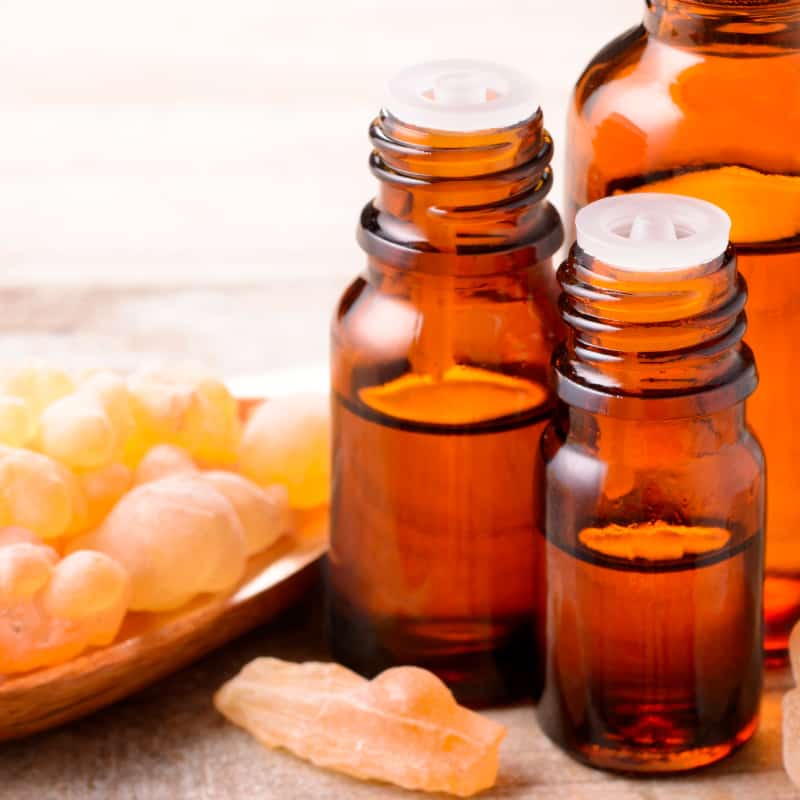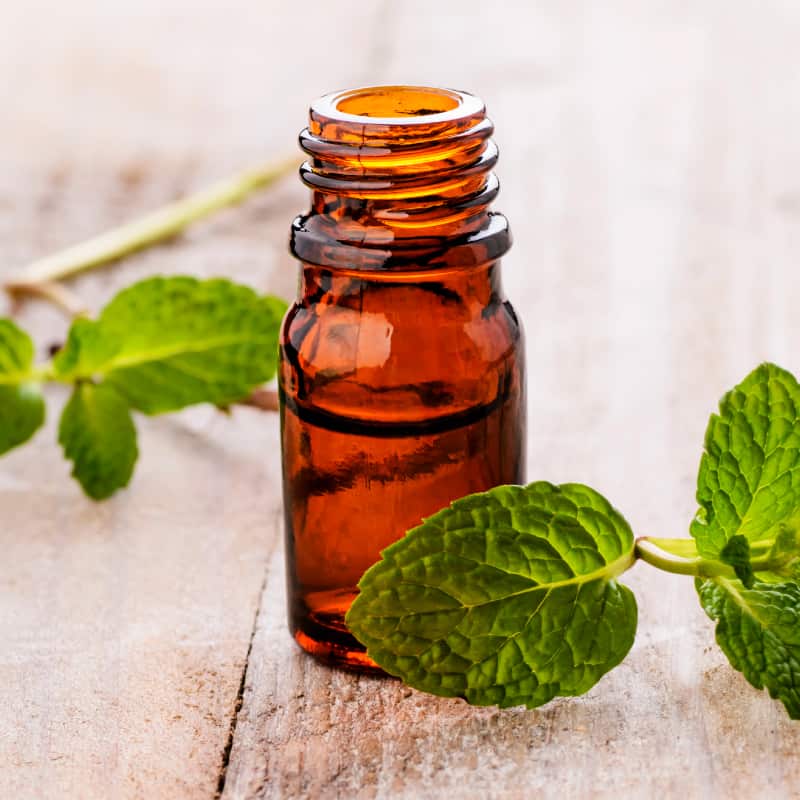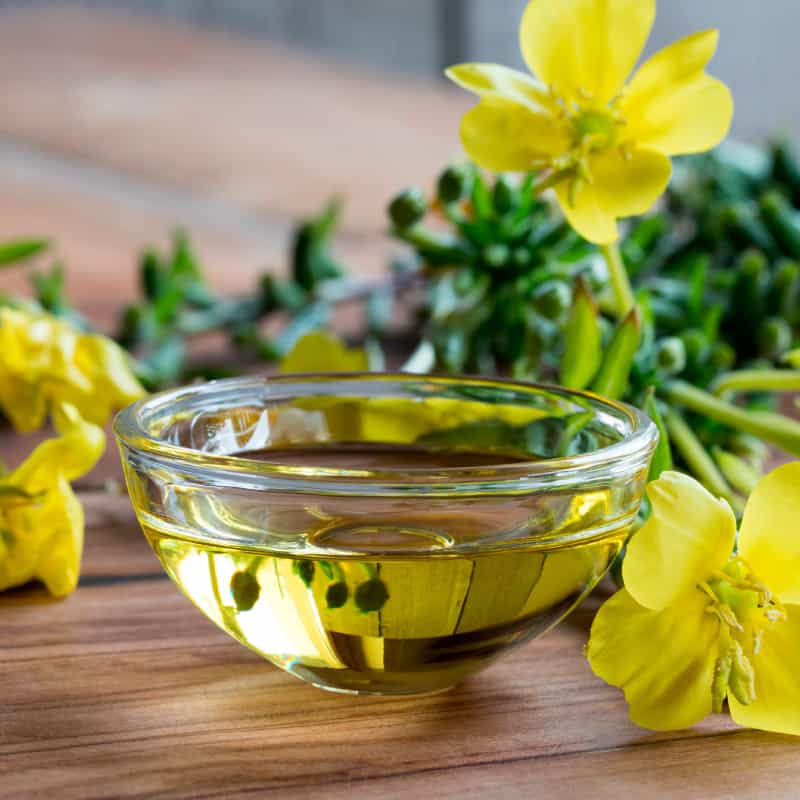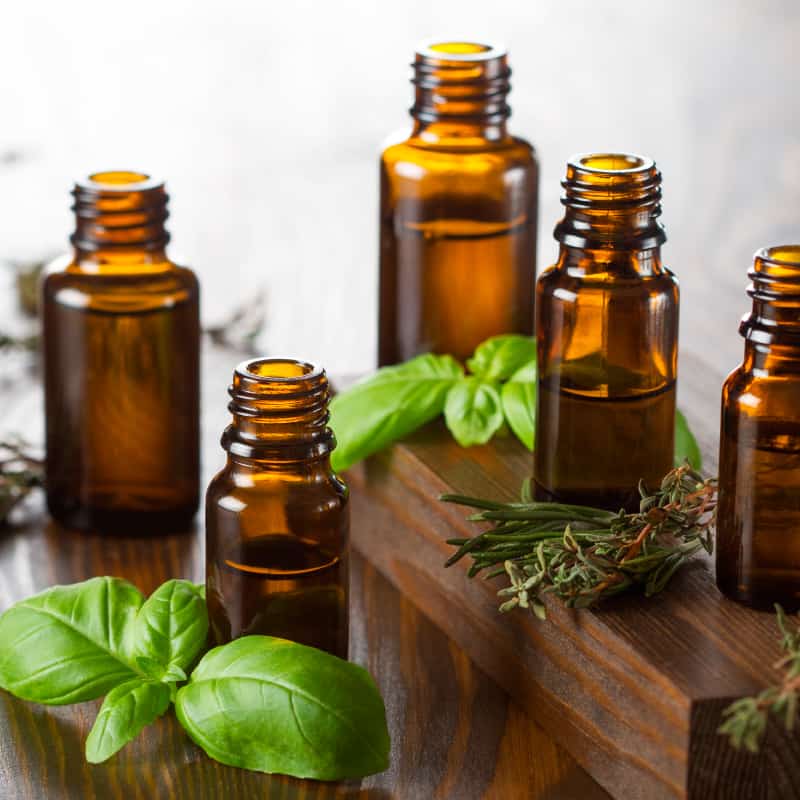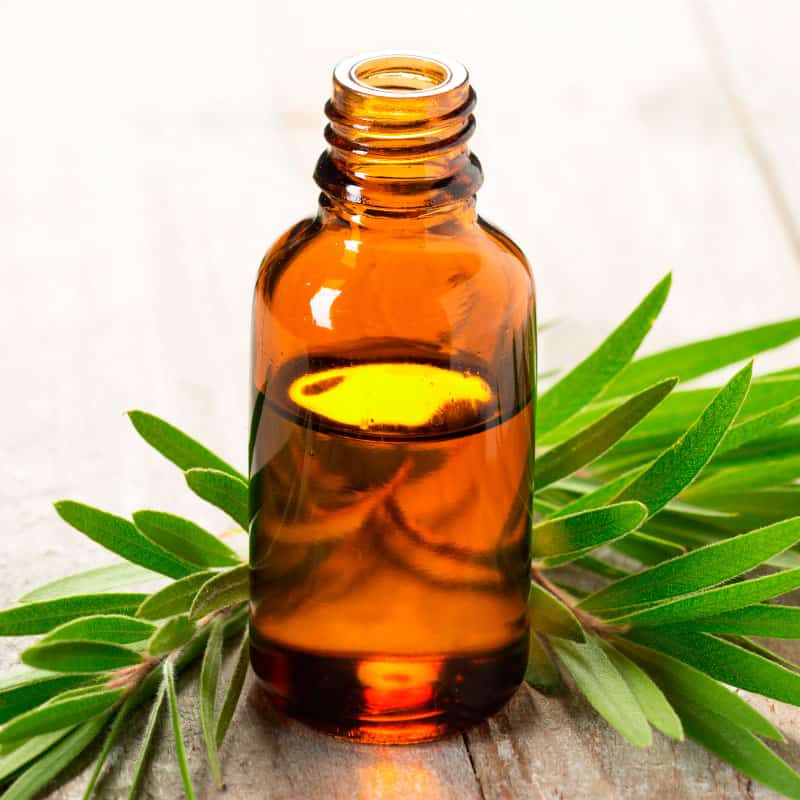This Dr. Axe content is medically reviewed or fact checked to ensure factually accurate information.
With strict editorial sourcing guidelines, we only link to academic research institutions, reputable media sites and, when research is available, medically peer-reviewed studies. Note that the numbers in parentheses (1, 2, etc.) are clickable links to these studies.
The information in our articles is NOT intended to replace a one-on-one relationship with a qualified health care professional and is not intended as medical advice.
This article is based on scientific evidence, written by experts and fact checked by our trained editorial staff. Note that the numbers in parentheses (1, 2, etc.) are clickable links to medically peer-reviewed studies.
Our team includes licensed nutritionists and dietitians, certified health education specialists, as well as certified strength and conditioning specialists, personal trainers and corrective exercise specialists. Our team aims to be not only thorough with its research, but also objective and unbiased.
The information in our articles is NOT intended to replace a one-on-one relationship with a qualified health care professional and is not intended as medical advice.
Fir Needle Essential Oil — Fight Cancer, Infections & Even Odor
June 7, 2018

The mention of fir needle most likely conjures up scenes of a winter wonderland, but this tree and its essential oil are year-round sources of enjoyment as well as good health. Fir needle essential oil is extracted through a process of steam distillation from fir needles, which are the soft, flat, needle-like “leaves” of a fir tree. The needles house the majority of the active chemicals and important compounds.
The essential oil has a fresh, woody and earthy scent just like the tree itself. Most commonly, fir needle essential oil is used to fight sore throat and respiratory infections, fatigue, muscle aches and arthritis. Fir needle essential oil is also utilized in the manufacture of cosmetic products, perfumes, bath oils, air fresheners and incense.
Fir (Abies) trees are a genus of 48–56 species of symmetrical, evergreen, coniferous trees belonging to the pine family. The root system of the fir tree helps prevent soil erosion. Fir trees are found through much of North and Central America, Europe, Asia, and North Africa, most often growing in the mountain regions of these continents. Fir needle essential oil most often comes from the fir needles of the Balsam fir (Abies balsamea) or silver fir (Abies alba) tree species.
Fir Needle Essential Oil Health Benefits
Some of the most common fir needle essential oil benefits include:
- Relieves arthritis pain
- Treats bronchitis
- Fights cold symptoms
- Treats coughs
- Combats flu symptoms
- Helps remove muscle aches
- Relieves rheumatic symptoms
- Remedies sinusitis
- Reduces fatigue
- Prevents infections
- Lowers pain
- Has antibacterial and antimicrobial properties
- Improves bone health
- Boosts respiratory function
- Detoxifies the body
- Reduces body odor
- Natural antiseptic
Top 9 Uses of Fir Needle Essential Oil
Like most essential oils, there is a large variety of ways you can use fir needle essential oil. Here are some of the best ways to put this essential oil of the forest to good use:
1. Cancer Fighter
Fir needle essential oil has been found to be an efficient anti-cancer agent. Modern studies out of France have shown the many anti-tumor characteristics in fir needle essential oil, making it a promising natural cancer treatment. The in vitro study demonstrates how fir oil and its active component alpha-humulene possess significant anticancer activity in several tumor cell lines and low toxicity to healthy cells. (1)
2. Infection Preventer
The essential oil of fir needle contains a high concentration of organic compounds that can aid in the prevention of dangerous infections. For this reason it can also be used as an active first aid agent. A balm or salve containing fir needle essential oil makes an excellent defense against infections.
In a study published in Phytotherapy Research, the antibacterial activity of fir needle essential oil was evaluated against Escherichia coli and Staphylococcus aureus, and the results showed that three constituents of the essential oil were active against S. aureus: alpha-pinene, beta-caryophyllene and alpha-humulene. This displays the infection-fighting power of fir needle essential oil. (2)
Powerful chemical compounds like tricyclene, alpha-pinene, camphene, limonene and myrcene can all be found in the needles of the fir tree. The chemical compounds of alpha-pinene and limonene in particular have been found to exhibit antimicrobial activities against common pathogenic bacteria and fungi. Research published in the World Journal of Microbiology & Biotechnology concludes that fir needle essential oil, along with other essential oils, displayed antimicrobial and antioxidant agents that would notably benefit products in the personal hygiene and care industry. (3)
3. Aromatherapy
Fir needle oil essential oil can be diffused or inhaled for its aromatherapy benefits. When diffused, fir needle essential oil is said to have a grounding and empowering effect stimulating the mind while encouraging the body to relax. (4) When you feel stressed or overtired, taking a whiff of fir needle essential oil can be just the thing to help calm and re-energize you, making it a great way to relieve stress.
4. Pain Reliever
Traditional and Ayurvedic medicine often employ fir needle essential oil as a natural analgesic. (5) To relax muscles and soothe body aches — important for muscle recovery — fir needle essential oil can be applied topically in a 1:1 ratio with a carrier agent. The stimulating nature of the oil can bring blood to the surface of the skin, hence increasing the rate of healing and shortening recovery time.
Fir needle essential oil can make an excellent therapeutic addition to a lotion or oil being used for a back or foot massage. If sore muscles are the issue, applying an oil, lotion or salve containing fir needle essential oil before bed can result in a less painful body by morning.
5. Detoxification
Fir needle essential oil contains active compounds that may trigger the body to rid itself of toxins. Due to the cleansing properties of fir needle essential oil as well as its free radical scavenging and bacteria destroying abilities, it can be helpful to people who are trying to detoxify their bodies. (6)
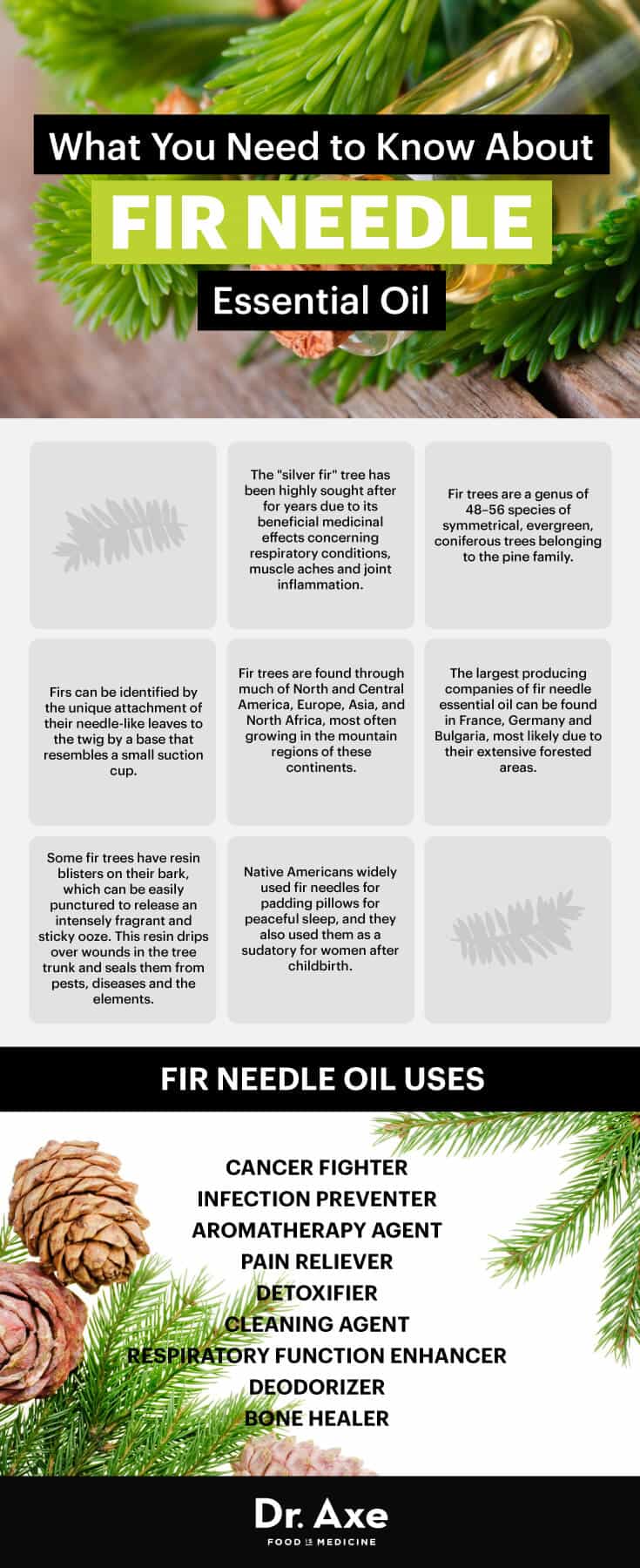
6. Cleaning
In general, essential oils make excellent additions to homemade cleaning solutions, and fir needle essential oil is no exception. The next time you’re creating an all-purpose cleaner, you can add a few drops of fir needle essential oil for a natural yet powerful disinfecting boost. (7) You can look forward to a home that smells refreshingly forest-like as well.
7. Respiratory Function
Cough? Sore throat? Try a few drops of fir needle essential oil in your diffuser and breathe in some natural relief. According to studies published in the Journal of Clinical Biochemistry and Nutrition, fir needle essential oil can be very helpful for respiratory issues that accompany the common cold and flu. (8)
When diffused or inhaled, fir needle essential oil can get to work relieving respiratory distress, working as a natural flu remedy. The essential oil helps loosen mucous and has an anti-inflammatory effect on the throat and bronchial tubes. In addition, fir needle essential oil fights free radical damage, another benefit to the respiratory system.
8. Body Odor
The fresh, clean smell of fir needle essential oil isn’t the only reason this essential oil is excellent defense against body odor. It also decreases the amount of bacteria that can lead to foul body odor. (9, 10) If you love the smell of the forest, you’ll love using products that contain this versatile essential oil.
9. Broken Bones and Osteoporosis
Fir needle often tops lists for the best essentials oils to assist with bone repair. (11) You can apply the essential oil to the problematic area three times per day, but remember to dilute it with a carrier oil like coconut oil in a 1:1 ratio before applying to skin.
Along with diet and exercise, essential oils like fir needle can be a very helpful natural treatment for osteoporosis. Again, a ratio of 1:1 of carrier oil to essential oil is recommended when using fir needle essential oil topically for bone issues.
History & Interesting Facts
The “silver fir” tree is most commonly used as a Christmas tree in the present day. However, it has been highly sought after for years due to its beneficial medicinal effects concerning respiratory conditions, muscle aches and joint inflammation.
The largest producing companies of fir needle essential oil can be found in France, Germany and Bulgaria, most likely due to their extensive forested areas.
Some fir trees have resin blisters on their bark, which can be easily punctured to release an intensely fragrant and sticky ooze. This resin drips over wounds in the tree trunk and seals them from pests, diseases and the elements.
Native Americans widely used fir needles for padding pillows for peaceful sleep, and they also used them as a sudatory for women after childbirth.
There is also white fur essential oil which comes from the white fur tree (Abies concolor). White fur oil has not been scientifically studies as much as silver fir or balsam fir oil.
The resin of fir trees can be used to make turpentine. Turpentine has been used medicinally since ancient times as a topical and sometimes internal home remedy. Topically, it has been used for abrasions and wounds, to heal cuts fast, as a treatment for lice, and as an ingredient in chest rubs. Many modern chest rubs still contain turpentine in their formulations.
Fir needles can be used to make a tea that is rich in vitamin C by simmering the needles in boiling water for 10 minutes. Typically, the ration is one teaspoon of needles per cup of water. It’s said to produce an incredibly robust, hearty and flavorful hot beverage.
Fir Needle Essential Oil Recipes
Fir needle essential oil is predominantly used externally but can be used internally under the right conditions. Most importantly, the essential oil must be of the very highest quality, which means a brand that is 100 percent pure, organic, therapeutic grade, and meant for internal consumption.
Secondly, an essential oil should be consumed internally only under the recommendation and supervision of a qualified health professional. When used internally, add one drop to four ounces of water or take as a dietary supplement mixing one drop of essential oil with one teaspoon of honey.
In terms of aromatherapy or homemade topical products, fir needle essential oil blends well with benefit-rich lavender oil, lemon essential oil, orange oil, majoram oil, pine oil and rosemary oil. To make an air-cleansing and uplifting room spray, simply combine four ounces of distilled water with 25 drops of fir needle essential oil, 15 drops of orange essential oil and 10 drops of lavender essential oil in a spray bottle.
Blending fir needle essential oil with other essential oils can also result in highly effective and very pleasant-smelling homemade cleaning products. You can include fir needle essential oil in homemade all-purpose cleaners as well as floor cleaners (see recipe below).
In terms of scent, pine oil can make a good fir needle essential oil substitute. If you compare fir needle vs pine essential oil, the two definitely have overlapping as well as different benefits, but for a cleaning recipe, the two can easily be substituted for each other.
Here’s one of my favorite balsam fir essential oil recipes:
Easy DIY Fir Needle All-Purpose Floor Cleaner
Total time: 2 minutes
INGREDIENTS:
- 1 gallon warm water
- 1/8 cup white vinegar
- 12 drops lemon essential oil or 1/4 cup lemon juice
- 8 drops fir needle essential oil
DIRECTIONS:
Mix all ingredients in a bucket. Mop floor as usual. Enjoy a naturally clean and disinfected floor!
Possible Side Effects of Fir Needle Essential Oil
As with all essential oils, never use fir needle essential oil undiluted. When used undiluted or in high concentrations, fir oil can cause skin irritation. Before applying any essential oil to your skin, it is highly recommended to perform a small patch test to an insensitive part of the body after you have properly diluted the oil in an appropriate carrier oil. Fir needle essential oil should always be diluted with a carrier oil like coconut oil in a 1:1 ratio before applying to the skin.
In addition, always avoid direct contact with your eyes or other mucus membranes when using essential oils. Fir needle essential oil, like all essential oils, should not be readily accessible or used without supervision by children. If you are pregnant or undergoing treatment for any medical condition, only use fir needle essential oil under the proper guidance of a qualified aromatherapy practitioner.
Final Thoughts
- Fir needle essential oil most often comes from the fir needles of the Balsam fir (Abies balsamea) or silver fir (Abies alba) tree species.
- Balsam/silver fir essential oil benefits include infection preventer, mood lifter, antibacterial cleaning agent, natural body deodorizer, bone helper and respiratory aid.
- Balsam fir essential oil blends with lavender, pine, rosemary and various citrus essential oils.
- When making homemade cleaning products, don’t forget about fir needle oil! It will leave your home clean and smelling fresh like a forest.
- Fir needle essential oil should always be diluted with a carrier oil like coconut oil in a 1:1 ratio before applying to the skin.
- Always purchase a fir need oil that is 100 percent pure, organic and therapeutic grade.





